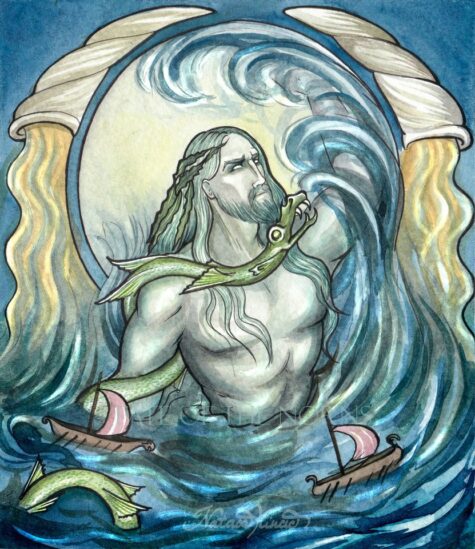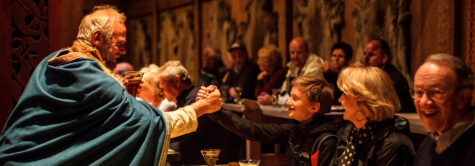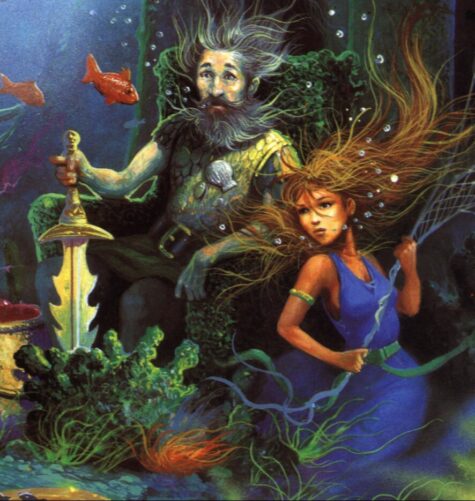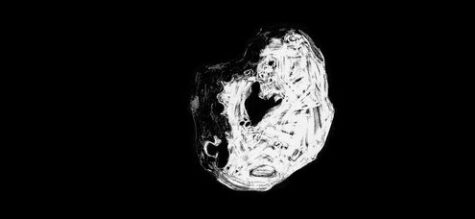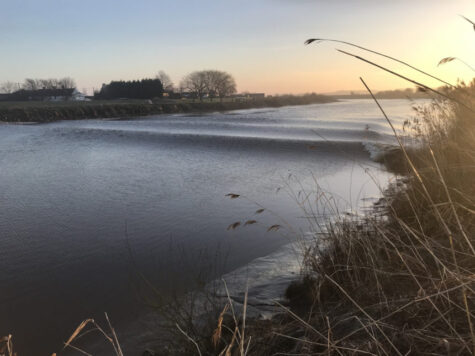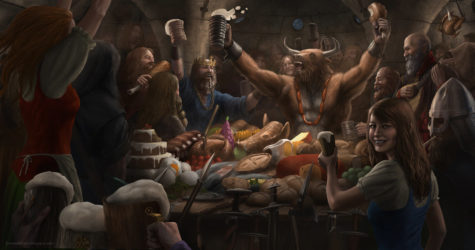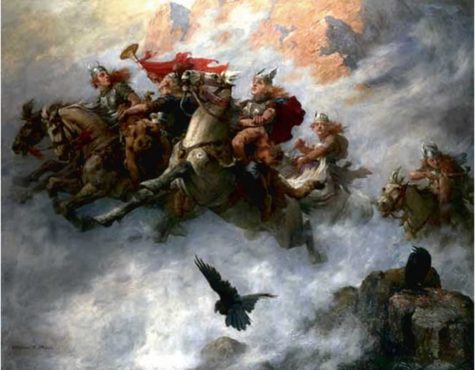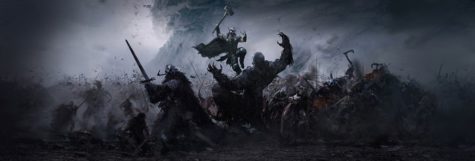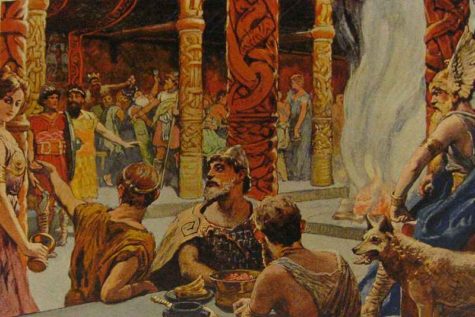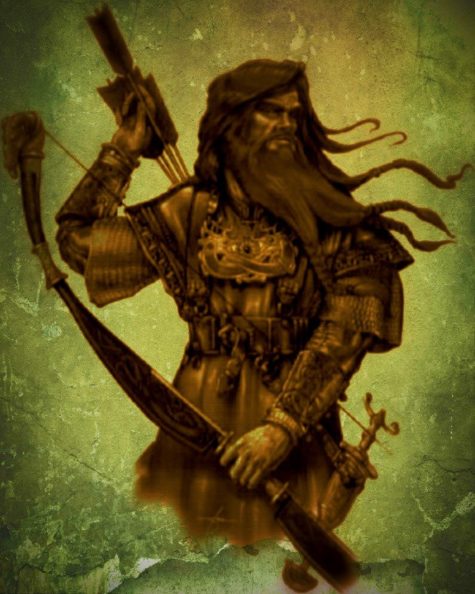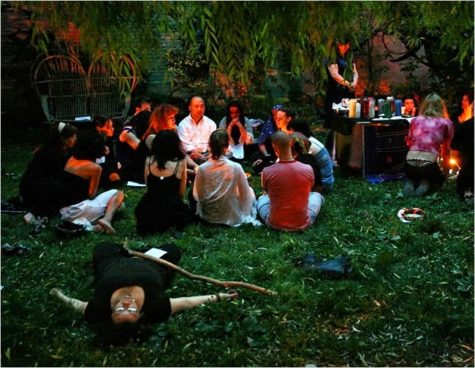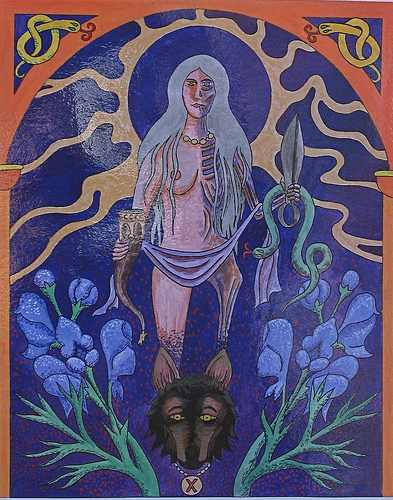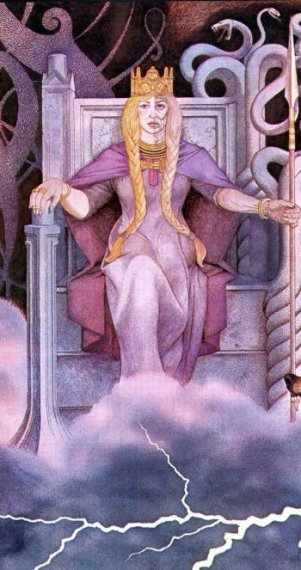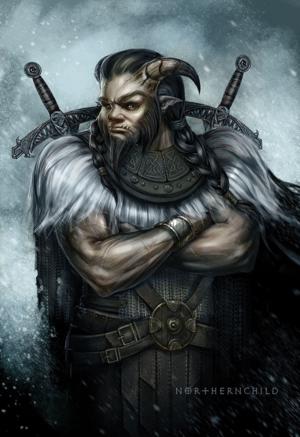Norse
According to some calendars, March 3rd is Aegir’s Day, this has also been referred to as the Celtic Sea Festival. The Pagan Book of Hours has a day for Aegir and Ran listed as July 25.
Ægir or Aegir is a Norse sea jötunn, a mythological giant (sometimes called a Frost Giant) and God of the sea. He’s also the brewer to the gods of Asgard. Aegir is also a God of brewing known for the beer he brewed in an enormous cauldron stolen from the giants by Thor and Loki. (Read that story here: Aegir’s Feast.)
He hosted elaborate parties, providing home-brewed ale in enormous pots. His mugs would magically refill themselves with more ale.
Married to the goddess Ran, they have nine daughters who each personify different kinds of waves.
Party and Celebration Ideas
To celebrate, have a party with a local microbrew and smørrebrød.
Roast Beef & Pickle Smørrebrød
- 1 slice rye bread, crust trimmed off
- 1/2 teaspoon unsalted butter, slightly softened
- 1/8 lb. sliced roast beef, cut into squares
- 2 to 4 cornichons (gherkins), thinly sliced lengthwise
- fried onions, (recipe below)
- 1 teaspoon prepared horseradish
Spread bread evenly with butter. Arrange roast beef on butter. Arrange cornichons and onion on top. Top with a dollop of horseradish.
Fried Onions
- Thinly slice a white onion.
- Soak in cold water for 10 minutes.
- Drain, then dredge onion in flour.
- Fry in hot oil until golden brown.
Ceremony for the Day of Aegir and Ran
- Date: July 25 – also known as 25 Haymonath
- Colors: Sea-blue, sea-green.
- Element: Water
- Offerings: Singing. Blood given to the ocean. Aid those who clean the seas.
- Song: Harp Song of the Dane Women, along with any other sea songs, sung as offerings.
- Daily Meal: Seafood.
Altar:
Upon cloth colored like the sea place shells, nets, figures of fish, sea floats, and anything that comes from the sea. Place there also a cup of wine with flecks of gold in it.
Invocation to Aegir, Ran, and the Nine Sisters
Lord and Lady of the Depths,
Keepers of the great flocks and herds
That float by the millions
Through glass-green waves,
Lady Ran of the ten-times-fingering weed,
Your hair spread throughout the worlds,
Lord Aegir of the great currents
And the waves that keep the ship afloat,
Generous in your bounty,
Capricious in your favor,
Brewer of ale for gods and lost souls,
Keep us safe as we pass over your realm
In life, in dreams, and in mystery.
Nine Sisters of the Waves, Sacred Undines,
Daughters of Aegir and Ran, fish-tailed,
Blood on your hands and beauty in your song,
We hail you from the shores, the depths, the heights of sea-cliffs.
Kolga the Cold One, Ice-Maiden of the floes and castles.
Duva the Hidden One, Keeper of island treasures.
Blodughadda, Blood-Haired One, shark’s delight.
Hronn, Sucking Whirlpool, Eel-daughter and Mistress of Fear.
Hevring, Heaving Storm, Mourning’s Mistress.
Bara, Great Wave of the Whale, battering the land’s stalwart stand.
Bylgja, Breaker’s Dancer, Rider of the Wave-Horse.
Unn, Billowing Tides, Maiden of the Counting Moon’s Rhythm.
Himinglava, Fair-Weather Mermaid, Sun Shining Through.
Teach us by the Powers of Water
How to find the way to our own souls.
Petitioning Aegir
Aegir is the presiding spirit of the ocean. He may also be understood as actually being the ocean. This ancient deity is beloved but feared. Petition him for safety on the seas and to reveal the secrets of the deep. Aegir knows everything. He is a well of knowledge and can theoretically fill any request or recruit another deity who can.
Petitions should always be accompanied with offerings. An altar may be built for him, or offerings may be brought to the sea. Be generous. He’s a king.
Give him objects reminiscent of the sea. Give him fine old coins – sailors once carried them so that in case they drowned, they wouldn’t arrive at Aegir’s hall empty handed. Serve him mead and ale, acknowledging that you know it’s nowhere near as good as what he serves at home.
Aegir – The Moon
Aegir, originally called S/2004 S10, is a natural satellite of Saturn. Its discovery was announced on May 4, 2005, from observations taken between December 12, 2004, and March 11, 2005.
Aegir is a member of the Norse group of moons. These “irregular” moons have retrograde orbits around Saturn—traveling around in the opposite direction from the planet’s rotation. Aegir and the other Norse moons also have eccentric orbits, meaning they are more elongated than circular.
Like Saturn’s other irregular moons, Aegir is thought to be an object that was captured by Saturn’s gravity, rather than having accreted from the dusty disk that surrounded the newly formed planet as the regular moons are thought to have done.
Aegir is about 6 kilometres in diameter, and orbits Saturn at an average distance of 19,618 Mm in 1025.908 days, at an inclination of 167° to the ecliptic (140° to Saturn’s equator), in a retrograde direction and with an eccentricity of 0.237.
The moon was named in April 2007 after Ægir, a giant from Norse mythology, the personification of tranquil seas, the one who soothes storms away. He is a son of Fornjót, and brother of Logi (fire, flame) and Kári (wind).
The name may be pronounced various ways. /ˈaɪjɪər/ (with the ‘g’ pronounced as a y-sound) approximates modern Norwegian and Icelandic. /ˈæɡɪər/ (with a hard ‘g’) approximates what the Old Norse may have sounded like, while the Latinized/spelling pronunciations /ˈiːdʒɪər/, /ˈɛdʒɪər/ and /ˈeɪdʒɪər/ are also found.
Aegir – the Tidal Bore
Aegir also gives his name to the tidal bore on the river Trent (in England) which is particularly powerful around the equinoxes. At certain times of the year, it is possible to see a bore of up to five feet high.
Aegir is said to rush up the river to try and reclaim the surrounding land and expand his watery kingdom.
The Trent Aegir is also known as the Eagre. The Aegir occurs when a high spring tide meets the downstream flow of the river forcing it back and causing a wave to flow upstream. Typically it is possible to see the bore from Derrythorpe to as far up the river as Gainsborough. Beyond Gainsborough the bore is reduced to a ripple.
The best places to see the Aegir are at Gainsborough, Morton, East Stockwith, West Stockwith and Owston Ferry.
The tidal bore is notoriously difficult to predict as there are several factors involved in its appearance but the Crowle Community Forum at Crowle.org does have an Aegir timetable which you can check out. (2021 predictions)
Sources:
January 9th is a day of remembrance for Raud the Strong. Here’s his story:
When Raud refused to give up Asatru (Icelandic for “Æsir”), King Olaf Tryggvason of Norway executed him by making him swallow a snake. His land and all his wealth was then confiscated.
Praise Raud the Strong by lifting a horn (or cup or glass) in his honor, and by doing something deliberate to spread the religion King Olaf tried so hard to stamp out. Alternatively, you might want to hold a Sumbel, a drinking-ritual in which a drinking horn full of mead or ale is passed around and a series of toasts are made, usually to gods, ancestors, and/or heroes of the religion.
The toasts vary by group, and some groups make a distinction between a “regular” sumbel and a “high” sumbel, which have different levels of formality, and different rules during toasting. Participants may also make boasts of their own deeds, or oaths or promises of future actions. Words spoken during the sumbel are considered carefully and any oaths made are considered sacrosanct, becoming part of the destiny of those assembled.
Today is the Feast of the Einherjar: The chosen heroes who sit in Odin’s Hall are the Einherjar. Today we honor those dead kin who gave their lives for Family and Folk. If you have friends or family who died in battle, visit their graves today, if that is not possible, drink a libation in their memory.
- See also: Honoring the Einherjar
Note: Also called Fogmoon, this feast day is held on the nearest weekend to November 1st. A celebration of the war-dead and of Ragnarok, it is dedicated to Odin and Freya.
Memorial Day is the day meant to be set aside to specifically honor the war dead. As such, it is an appropriate day to observe rituals to honor the Einherjar: the battle-slain warriors who are taken to Valhalla.
Who are the Einherjar? They are an army of all men who fall in battle, they are adopted as Odin’s sons. He allots to them the halls Valhalla and Vingólf. There they await Ragnarok, when they will join the Gods in fighting the Giants. They spend most of their time fighting, eating, and drinking.
Of course, not all of the battle-slain go to Valhalla some also go to Freya’s Hall, but many modern pagans will honor the war-dead, especially their ancestors who served at this time.
Others will honor the Einherjar on Veteran’s Day instead, even though, technically Veteran’s Day is intended to first and foremost honor those living Veterans from past military service, it is also used to honor those currently serving, and to a lesser degree those soldiers now dead.
For more about the Einherjar – read on…
In Norse mythology, the Einherjar (Old Norse “lone fighters”) are those that have died in battle and are brought to Valhalla by Valkyries. In Valhalla, the Einherjar eat their fill of the nightly-resurrecting beast Sæhrímnir, and are brought their fill of mead (from the udder of the goat Heiðrún) by Valkyries. The Einherjar prepare daily for the events of Ragnarök, when they will advance for an immense battle at the field of Vígríðr.
“Valholl is widely spread out;
here Odin chooses every day
weapon-slain warriors…”
In Norse cosmology, those that die in battle hold a special role within Asatru. They are the Einherjar, those that are chosen by Odin to fight on the side of the Gods at Ragnorak. (see explanation below)
Accounts of Valhalla describe it as a large hall, decked with the implements of battle. The Einherjar are described as being well-hosted, they are fed on pork and mead, and each day, the Einherjar practice at the art of battle. They engage one another in terrible, bloody conflicts, and at the end of the day, come back to life, and walk off the field, the best of friends.
All the Einheriar fight in Odin’s courts every day;
they choose the slain and ride from battle;
then they sit more at peace together.
It seems probable that historically, the Einherjar could be best described as some sort of “elite” troops, and that going to Valhalla was not necessarily the fate of the common soldier. Odin was traditionally followed by members of the ruling classes, not by ordinary folk. Adding to this the idea of the Einherjar fighting day after day, and enjoying it immensely does seem more in line with an elite unit, it seems likely that an ordinary draftee might get a little tired of day after day of fighting.
In actual modern-day practice, Einherjar blot has tended to become a day to honor all of those who die in wars, and to a lesser extent, veterans in general. How exactly does one reconcile these two different images of the Einherjar? One thing is clear, it was never a part of old Norse thought to hold to one view of the afterlife. Where you ended up after your death seemed reliant on which Gods you followed in life, and what sort of person you were.
Hail those that serve!
Hail the fallen!
Hail the Einherjar!
Note:
In Norse mythology, Ragnarök (Old Norse “final destiny of the gods”) is a series of future events, including a great battle foretold to ultimately result in the death of a number of major figures (including the gods Odin, Thor, Týr, Freyr, Heimdall, and Loki), the occurrence of various natural disasters, and the subsequent submersion of the world in water.
Afterward, the world will resurface anew and fertile, the surviving and reborn gods will meet, and the world will be repopulated by two human survivors.
Sources: Wikipedia and Raven Kindred
The Feast of Ullr was traditionally a hunting festival. Ullr, god of hunting, and the bow was honoured and a feast was shared by the tribe of the spoils of the hunt. I remember hearing somewhere about Skathi also being honoured on this day but I can’t recall where… Anyway, in addition to being the goddess of skiing, she also governs hunting and bows.
The tribe (or family) on this day would take a portion of the meat from the hunt and have a large and joyous feast before the winter sets in hard. Today, most of us do not hunt, we get our meals from the super market, and if we are lucky, we grow a small amount of herbs and vegetables for eating. But we always get our meat from the grocery store. So celebrating a feast of the hunt is not as powerful a gesture in out modern times.
Many Asatruar in the USA use the national Thanksgiving holiday to honor our Gods and Goddesses of the hunt (it is deer hunting season in many parts of the country). We thank them for a successful hunting season with a blot and also bless/honor those who hunt to support the family. Weapons are dedicated on this day to Ullr. Some also take advantage of the family-oriented secular holiday to honor their personal ancestors.
One way to do this is to set an extra place at the table and leave it empty so that any ancestor who wishes may join us for the feast. This is a great time for telling tales handed down through the family. Still other Asatruar refer to this holiday as “Weyland Smith’s Day” and use it to honor that great Germanic craftsman as well as those artists and artisans around us.
On this day also, you may want to take time out with family and friends to shoot bows, throw some axes, play some Kubb and always playing a little Glima (Scandinavian Folk Wrestling of which Ullr is still remembered as the god of).
Collected from various sources including Jake Jackson and Pagan Space
This ritual is held on or about the day of St. Martin, a Catholic saint who was given many of Odin’s original attributes. There is strong evidence that this day (Nov 12) was originally a festival time devoted to Odin and to Cernunnos, who has many similarities to the Wanderer.
This is a time of festival for several families gathered together, each bringing food and drink for the potluck feast. Prior to the time of the rites, have a day of games and feasting. The ritual should be held out of doors if possible, with the area appropriately decorated for the season with grain, fruits, maize, vegetables, nuts, leaves and flowers. Some of the last remaining Halloween decorations may be used for a final time on this day. place banners of Odin and Freya at the northern edge of the ritual area, or some appropriate other symbols of the female and male in the Divine. Whatever symbols are used, light a candle or torch before each of them.
At the beginning of the rites, the Master of the House summons the celebrants by the blowing of a horn. When all are gathered, he and the Lady of the House light candles and give them to all of the children present; then they lead the children in procession about the perimeter of the ritual area. Upon the return of the slow procession to the starting point, they instruct the small ones to place their lamps at the edge of the ceremonial area, saying:
Place this light
At the edge of our festival
So that the Great Ones
May be with us.
When all are in readiness, the Master of the House raises his hand and says:
Friends, I now bid thee
To join in a celebration
To our patron, the wise Odin,
Known also by his other names
Of Cernunnos and St Martin
The Lady of the House then says:
We call too upon Our Blessed Lady,
The good Freya
Queen of the Harvests, giver of life
And of plenty
Since before time began.
The Master of the House calls to the assembled family members:
Let us all give thanks
For the foods of the harvest, and
For the Challenge of the hunt.
May the wise Allfather bless our homes
And bless our animals, one and all.
So mote it be.
Everyone responds:
So mote it be.
The Lady of the House then calls:
Let us all give thanks
For the fullness of this time,
For the rich promise of the harvest time,
And for the love which binds our families
And our people.
May the Holy Lady bless our homes,
Our families, and all we own.
So mote it be.
Everyone responds
So mote it be.
Both then link hands and call to the assembled family members:
May our Lord and Blessed Lady
Give blessings upon us.
Let us give joy and reveling
Before the Great Ones,
And in so doing, honor them.
This rite is ended.
The Gods be with thee.
Everyone together:
The Gods be with thee.
The children are then asked to blow out the candles that they have set about the area of the ceremony.
From The Rites of Odin
July 29, is the festival of the Anglo-Saxon god Thunor and the Norse god Thor, a time of ascendant power and order. The great thunder-God Thor was honored on this date with prayers for protection of the crops against destructive storms in the older times in Europe.
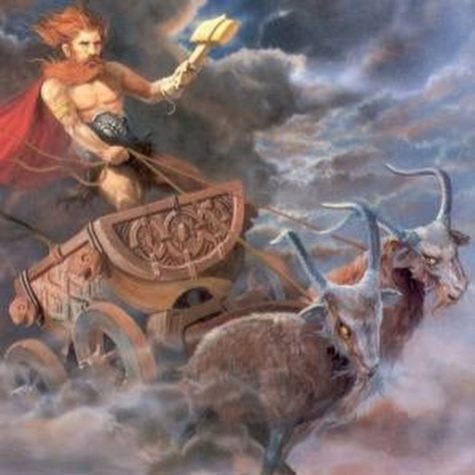
Prayer to Thor for Strength
by Seawalker
Thunder rolls, lightning strikes,
And the hammer flies across the sky.
God of the weather, chariot of the storm,
Master of rain and torrents,
Son of the strength of Mother Earth,
I ask you to grant me that strength for myself.
You who are so great that you cannot walk
Across the Rainbow Bridge without breaking it,
You whose tree is the mighty oak,
O Thunor, grant me that unending sturdiness.
Let me not break beneath the blows of misfortune.
Keep me from being crushed when the powerful
Stomp their large feet on the smaller ones below.
You who are the guardian of the common man,
You who care for the farmers and workers,
Look upon me here in this place where I am
Only one of many, and protect my steps.
Make me resilient and mighty as your own arm,
Make me unbreakable, you who are Friend of Man.
I ask for one small percentage of the vigor
Of the right arm of the Thunderer,
That I might brave the tempest
And stand firm in the gales.
Thunder rolls, lightning strikes,
And the hammer flies across the sky.
Found at Thor’s Shrine
The Anglo-Saxon and Norse Goddess of the Underworld is honored annually on the Day of Hel (July 10th) with prayers, the lighting of black candles, and offerings of rose petals.
About Hel:
Also known as Hella, Hela, this deity is simultaneously half-dead and half-alive. Half of her body (cut vertically) is that of a fair, beautiful woman; the other half is necrotized flesh. She is half living woman, half corpse.
Once upon a time, being sent to Hel may have been inevitable, but it wasn’t perceived as punishment: Hel, daughter of Angerboda and Loki, rules the Norse realm of the dead. She is the keeper of the souls of the departed. Those who die at sea or in battle have other destinations; everyone else goes to Hel, who welcomes them into her home, Helhaim, regardless of whether they were good, bad, sinful, or saintly while alive.
Here’s a ritual for Hela’s Day:
- Colors: Black and White
- Elements: Earth and Air
- Altar: Upon black cloth to the right place four black candles, a skull, bones, a pot of earth, a pile of withered leaves, and a gravestone. Upon white cloth to the left place four white candles, incense, an ivory chalice of mead, a crystal sphere, and a bunch of dried roses. Veil the windows.
- Offerings: Blood. Pain. Difficulty. Toil. An arduous task that will take all you have to give, and will benefit the generations yet to come.
- Daily Meal: Meat stew and bread.
Invocation to Hela
Hail to Hel
Queen of Helheim
Wisest of Wights
Keeper of Secrets
Keeper of the hopes for tomorrow
Guardian of Souls
Implacable one of the frozen realm
Half the face of beauty
Half the face of Death.
You who feed the dead
At your meager table
Where everyone gets their fair share,
You who care not
About wealth or status,
About fame or fortune,
Who cares for the peasant
Equally with the ruler,
Teach us that Death is the great leveller
And that we need have no pride
When we reach your halls.
Lady who takes away
Yet holds always promise,
Teach us to praise loss and death
And the passing of all things,
For from this flux
We know your blessings flow.
(Blow out the candles, bow to the altar, and pour out the libation of mead. The roses should be placed outside to rot in the garden.)
Found in: Pagan Book of Hours
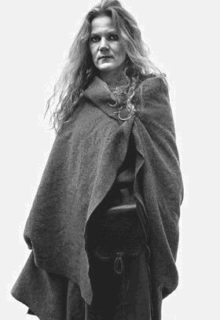 July 9th is the Day of Unn the Wise person. Also known as Aud the Deep-Minded, Unn was a great matriarch who established dynasties in the islands Orcadas, Feroe and Iceland.
July 9th is the Day of Unn the Wise person. Also known as Aud the Deep-Minded, Unn was a great matriarch who established dynasties in the islands Orcadas, Feroe and Iceland.
Example to follow:
Make our own families grow strong, maintain the memory and traditions of our alive ancestors. Remember the great women of your own clan on this Day of Remembrance for Unn the Deep Minded.
About Unn:
Unn was a powerful figure from the Laxdaela Saga who emigrated to Scotland to avoid the hostility of King Harald Finehair. She was the second daughter of Ketill Flatnose, a Norwegian hersir, and Yngvid Ketilsdóttir, daughter of Ketill Wether, a hersir from Ringarike. Unn married Olaf the White (Oleif), son of King Ingjald, who had named himself King of Dublin after going on voyages to Britain and then conquering the shire of Dublin. They had a son named Thorstein the Red
She established dynasties in the Orkney and Faroe Islands by carefully marrying off her grand daughters. Unn then set off for Iceland.
On her ship were twenty men, all of whom were free, but she was still the leader of them, proving that she was respected, but also that she was strong-willed enough to command a ship alone without the help of a man. In addition to the crew, there many other men on her ship, prisoners from Viking raids near and around Britain. They all came from good families, and were called bondsmen. Unn gave these men their freedom once they were in Iceland, making them freed-men, a class between slave and free, where they were not owned, but did not have all the rights of a free man. She also gave them all a great deal of land to farm on and make a living.
As a settler in Iceland she continued to exhibit all those traits which were her hallmark-strong will, a determination to control, dignity, and a noble character. In the last days of her life, she established a mighty line choosing one of her grandsons as her heir. She died during his wedding celebration, presumably accomplishing her goals and working out her destiny in this life. She received a typical Nordic ship burial, surrounded by her treasure and her reputation for great deeds.
Note:
In some pagan calendars this is shown of “Day of Un the Wise Person” which is a misprint.
Source: Asatru.org
June 14 is sacred to the Viking god Vidar. He is one of the sons of Odin and destined to survive Ragnarok and rule over the earth afterwards. He is the personification of the vital energy of nature which returns greening the land even after major disasters.
He is the patron of leather workers. According to Viking tradition, leather workers would put aside all of their off-cuts. These scraps of leather would be buried as offerings to Vidar, and to remove bad luck and evil vibes from the giver.
Vidar gathers these leather scraps to make his enormous, tough leather boot, and at the end of time he will stop Ragnarok when he kills the Fenris wolf by booting it in the mouth.
Later, Christianity changed Vidar to St. Vitus.
Source: Raven Corbis
